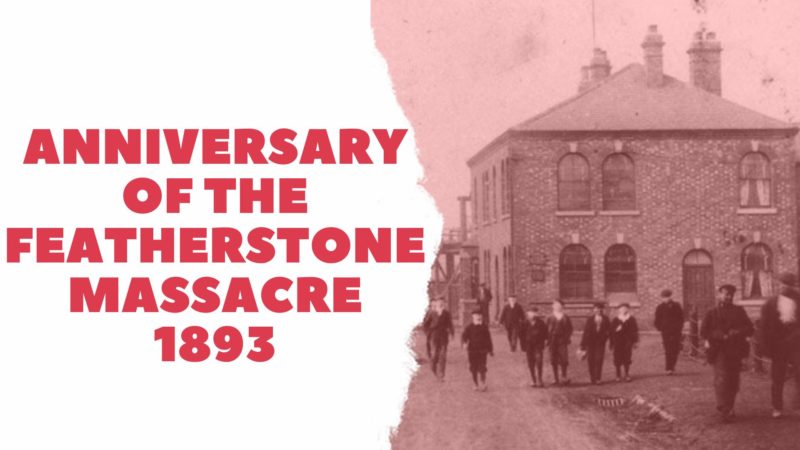Jon Trickett A strong Yorkshire voice for Hemsworth constituency

The date of September 7th, lives on in infamy in the township of Featherstone in my constituency. What happened that day resonates down the decades ever since in our area.
It was the last time in England that British soldiers turned their guns on hard working people struggling for a decent wage.
After two years of coal prices plummeting, in 1893 the price of coal fell by 35%.
The bosses did what they always do. They slashed the men’s wages.
Speaking at the Yorkshire Miners Association (YMA) demonstration held at Wakefield, the miners’ leaders said ‘No reduction will be submitted to. We intend to stick to what we have got. We got it by conquest and it will have to be taken away from us by conquest.’
In June 1893 the employers formalised a cut in pay of 25%.
The unions opposed the cut and the men were then locked out of work right across the West Riding’s 253 pits (around 80,000 miners).
The lockout was peaceful: On 2 September the Barnsley Chronicle stressed the law-abiding conduct of the colliers: “the state of affairs is the quietest ever known in such a lockout. The men are walking about spending their time as best they may, but always […] quiet and orderly.”
This peace did not last, however. The coal bosses began to move the coal using blackleg labour.
The papers then reported that “Yorkshire suffered a breakdown in law and order to a degree not experienced since the days of the Luddites and the Chartists. Civil disorders spread to many parts of the coalfield and rioting became a daily occurrence.”
Collieries where it was known, or rumoured, that coal was being loaded into railway wagons were subjected to attacks by crowds of miners.
The miners, and their families, were by this point plunged into hardship and hunger.
On the day in question, the police were slow to act. Many of them had been dispatched to the St Leger Race in nearby Doncaster. “The local police regarded Featherstone as one of the least likely places where rioting could be expected, and two of the three constables stationed in the town were sent to Doncaster to assist in the supervision of the races.”
In the absence of police that day, troops and police from other areas were drafted into the county and soldiers were stationed in the mining districts.
On September 7th rumours spread that coal at Ackton Hall pit which was open to men from Ackworth – the village where I live now – and Featherstone – was being loaded onto wagons and then being transported to the owner’s mill in Bradford. People gathered at the site where they confronted the pit manager there.
This is when soldiers were brought in and the Riot Act was read by local magistrate Bernard Hartley.
When the crowd didn’t disperse, the army was ordered to fire warning shots. Instead of shooting over the heads of the crowd as they ought to have done by law, they fired straight into the crowd. After a second volley of shots 8 people were injured, two, James Gibb, 22, and James Duggan, 25, died from their injuries.
Neither man was involved in the disturbances and it has been noted that James Gibb had only happened to see what was going after hearing the miners whilst walking through fields. One man who was reportedly 250 yards away was injured, so powerful were the army’s rifles.
People in the crowd by shouting ‘we would rather be shot than be hungered to death’.
These events led many working people to break with the then governing Liberal party and led directly to the increasing number of people supporting the Labour Party. Indeed, meetings in the area were regularly addressed by leading socialists, including Keir Hardie.
It is important to understand our history and how it was that out of struggles such as those of the Yorkshire mine-workers, socialism became rooted in working class communities.
But there is also another lesson from those days long ago. That is that the leopard never loses its spots. The bosses today are once more at it. They are launching an all-out attack on the incomes of working people using the pandemic as an excuse.
Don’t believe me? Take a look at the actions of British Airways or Rolls Royce. They are actively plotting massive cuts in the incomes of their employees. And they are reaching back for the old techniques. In effect the idea is for bosses to lock out – or indeed sack – the whole workforce. They will then immediately offer the same jobs again to the same workers but on substantially worse pay and conditions.
Some might think that this is illegal. But it isn’t and even as we read this article there are HR consultants who are offering to show employers how to achieve this.
Also we have seen that nearly a fifth of UK businesses have asked staff to take a pay cut to shore up the firm’s finances and help stave off redundancies, according to a survey by the Chartered Institute of Personnel and Development (CIPD).
The whole Labour Movement will need to galvanise itself in the struggles to come.
This article originally appeared on Labour Outlook, which you can access here.
